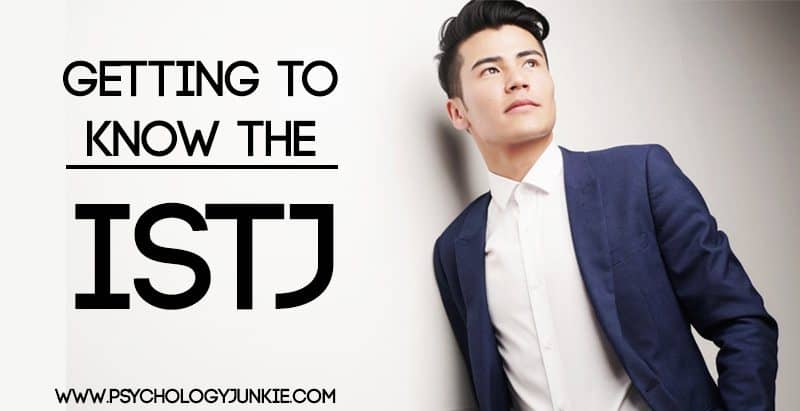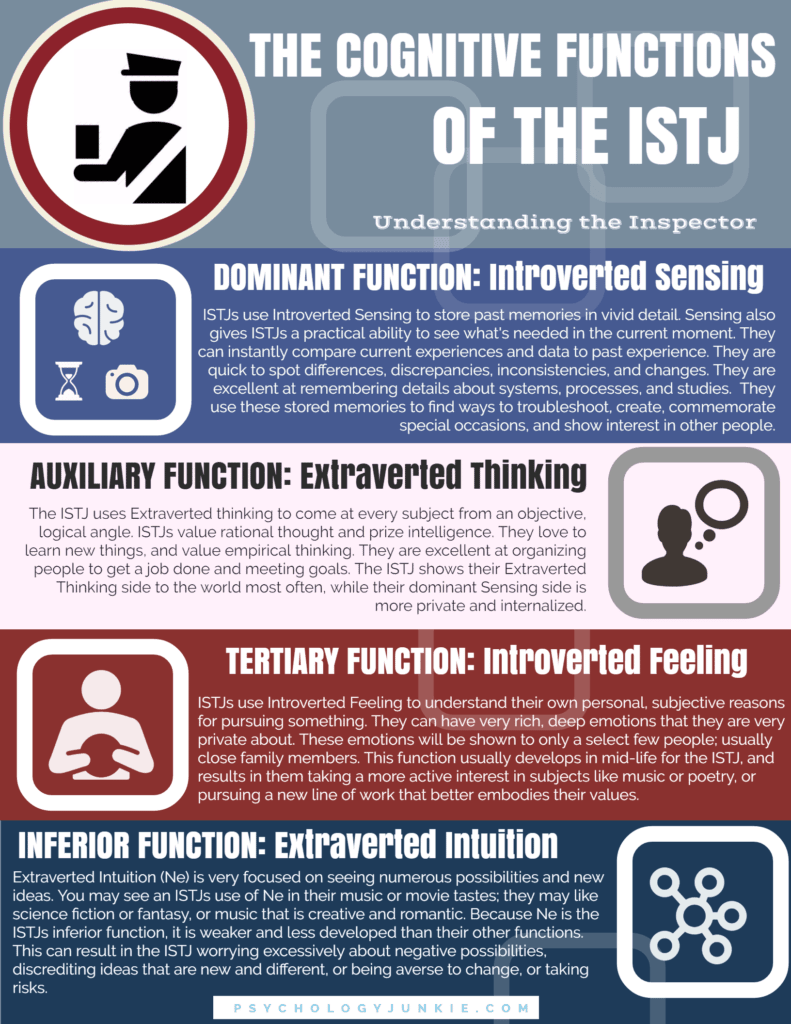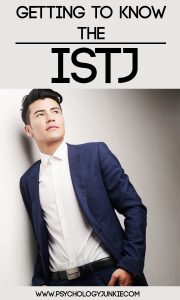Getting to Know the ISTJ
“Discipline is the soul of an army. It makes small numbers formidable; procures success to the weak, and esteem to all.”
– George Washington, an ISTJ
ISTJs are one of the more misunderstood and fascinating personality types out there. As a practitioner, I don’t know how many times I’ve sat down with ISTJs who say something to me like, “oh yeah, I’m the boring, pencil-pushing personality type..”. They may be joking, but the personality community has done nothing to help this one-dimensional stereotype. ISTJs are so much more than “pencil pushers” and the blind conformists that certain egotistical people make them out to be. The goal of this post is to paint a true portrait of the mental processes or cognitive functions that ISTJs use. You’ll see that there is much more to them than the stereotypes would imply.

Not sure what your personality type is? Take our new personality questionnaire here. Or you can take the official MBTI® here.
The ISTJ’s Dominant Function: Introverted Sensing (Si)
Introverted Sensing is the function that ISTJs master with the most ease and clarity. There are a lot of misconceptions about Si, but what it really stands for is “sense impressions.” ISTJs are fact people. They trust what they perceive through their senses. They like to know what is proven, truthful, or verifiable. They are less likely to move forward on something based on a “hunch” or gut feeling than they are to move forward on something based on careful planning, research, and personal experience.
Introverted Sensing is more than a trust in facts and data, however. Si captures “impressions” throughout life of different experiences. These impressions and visuals are extremely vivid and detailed. Throughout life, the ISTJ will draw from these impressions to compare and contrast current data. This makes the ISTJ very skilled at noticing shifts in patterns and behavior. Because they remember these stored impressions and details with such accuracy, they can tell when the pattern shifts or transforms. Many ISTJs mistype as Ni-users (INXJs), because so many personality tests attribute noticing patterns to Ni, when in fact Si is also very skilled at this.
ISTJs are also quick to pick up on social cues and changes in behavior. According to neuroscientist Dario Nardi, ISTJs show high activity in temporal region T5. This region helps them to attend to social feedback. As a result, when ISTJs notice negative feedback (an offhand glance, a frown, a change in behavior) they respond quickly. They often feel intense shame or embarrassment when they feel they have acted inappropriately. They may “intuitively” know what things will or won’t set other people off or irritate them as a result.
Si also gives the ISTJ a view of the world that spans the past, present, and future. Si-users can have an experience and realize its significance in how it relates to past experience, how it is important now, and how it will influence the future. I’ll let Carl Jung explain because he does this much better than I can.
“We could say that introverted sensation transmits an image which does not so much reproduce the object as spread over it the patina of age-old subjective experience and the shimmer of events still unborn. The bare sense impression develops in depth, reaching into the past and future, while extraverted sensation seizes on the momentary existence of things open to the light of day.”
– Carl Jung, Psychological Types
Here’s an example of how introverted sensing can work:
Imagine that you’re at a family picnic. You’re watching your children fly kites at the park. Suddenly you see an image of yourself flying a kite as a child, you feel the wind in your hair, the gentle tug of the kite as it glides on the breeze. Now you move to the present moment and see your son with his kite, you notice his enthusiasm and you can almost feel it inside yourself, the same way you did as a child. You realize this moment is fleeting and someday he will be grown and you hope one day he will be able to see his own children this happy.
You can see how the introverted sensor compared the current experience to his past experience, how he almost “felt” the same feelings he did then. You can also see how he saw the fleeting nature of the moment and saw a future for his child.
Now the ISTJ doesn’t go through life seeing every single experience this way, but he will have these strong impressions regularly. Carl Jung said, “What will make an impression and what will not can never be seen in advance, and from the outside.”
It’s important to remember that not every Si experience or impression is focused on these sort of wistful, magical moments. Sometimes Si causes the ISTJ to retain detailed facts and pictures from the past. He might be able to compare current problems to past problems to find a solution, or to see an error that needs fixing.
The Auxiliary Function: Extraverted Thinking (Te)
Te is the function that you will see most readily from the ISTJ. This is the function he “extraverts” or shows the world. As a Te-user, he (or she) will be logical, organized, precise, and focused on efficiency. In decisions, he will try to be objective, unbiased, and fair. He will focus on the pros and cons and impersonal analysis to find the best course forward. Rational honesty is important to him, and as a result, he can distrust sentiment or decisions made by emotions, which he sees as ever-changing and unreliable.
ISTJs like to be organized and to organize, and Te is a great contributor to that. They like to figure out efficient systems, plans, and routines. They like to create spreadsheets or write out diagrams for how things can be effectively run and maintained.
Extraverted Thinking types like to learn so they can do something with what they’ve learned. They like to be productive. However, because the ISTJ tempers Te with his dominant Si, he takes the time to consider all the details, all his personal experience, and all the patterns and implications before moving forward on a decision. He needs time to think things over before deciding. That said, he tries to decide relatively quickly because Te is a rather impatient function. It doesn’t like to be left waiting. It wants enough information to decide, and then it likes to decide with quick resolve.
The Tertiary Function: Introverted Feeling (Fi)
ISTJs will almost always favor Te over Fi. However, Fi is still a powerful process that gives the ISTJ a certain integrity and resolve that is admirable. Introverted Feeling isn’t so much about pure emotions (this is a misconception), it’s about being authentic, honest, and adhering to one’s values. You will see Fi in an ISTJ by the way they adhere to their beliefs, stick to their morals, and refrain from “sugarcoating”. Anything that seems manipulative or wishy-washy is distrusted and cast aside. While the Fi of the ISTJ doesn’t look nearly the same as the Fi of the ISFP, there are still similarities. The ISTJ won’t bend or compromise what they believe is the right or true way to go. While the ISTJ might not dwell on his or her emotions a great deal, he will still feel a compulsion to live up to his morals and standards and be honest.
The Inferior Function: Extraverted Intuition (Ne)
ISTJs will feel a simultaneous push and pull towards Extraverted Intuition. As the inferior function, it is far less conscious than any of the other primary functions. Personality Hacker calls the inferior function “the 3-year-old,” stating that it has a 3-year-old’s level of maturity. Mature Ne sees many possibilities and theoretical avenues that could be traveled in the future. It loves brainstorming and is ready for constant change, innovation, and improvisation. Ne-users like to project about what “could be” a great deal.
For the ISTJ, security and consistency is the ideal. They like to know what to expect and what (or whom) they can count on. They tend to dislike sudden changes, theorizing about multiple possibilities, or focusing entirely on abstract possibilities. This doesn’t mean they never like doing this. The inferior function is still very powerful, and they may have bouts of insatiable curiosity about the future and the possibilities it holds. However, more often than not, when it comes to their daily life they like to wager on trusted facts, “tried and true” techniques, and what they know as effective through personal experience.
ISTJs may engage in healthy Ne-focused activities; reading science fiction books, trying out a novel solution to a problem, questioning pre-ordained rules and structures. They may also engage in unhealthy Ne; catastrophizing about negative possibilities, brainstorming excessively to no productive end, misreading signs and patterns as indicative of some terrible future.
Stressed ISTJs can fall “into the grip” of Extraverted Intuition. When this happens, they can see nothing but bleak possibilities and feel an intense dread of the unknown and the future. You can read more about this here.
Healthy ISTJs will find small ways to engage in Ne in day-to-day life. They can do this through theorizing about the future, reading books that deal with complex future realities (even if they’re fiction!), or they can use Ne and Si together by playing games that utilize creative thought and pre-gained knowledge. Many ISTJs enjoy playing puzzle games, or games like Sudoku or Scrabble. Some Si-dominant types also use their Ne in a hands-on way; by experimenting with a craft or project and creating many varieties within that project. For example, my STJ mother-in-law enjoys creating numerous different styles of quilts. She doesn’t like to stick to the same old design every single time.
Ne gives the ISTJ a fun, imaginative, creative side that they like to employ in some kind of a practical way or else through leisure.
What the Healthy ISTJ Looks Like:
Healthy ISTJs are analytical, honest, and responsible. They have an intense memory or impression of the past, present, and future, and they strive to align all three in a healthy, cohesive way. They believe in bettering their communities and staying true to their word. On the outside, they can seem aloof, reserved, and especially frank and straightforward. But on the inside, they have integrity and a world of beautiful impressions that live and breathe and give them a certain thoughtfulness and maturity.
ISTJs are far from the stereotypes you’ve probably heard about them. Yes, they tend to trust tried-and-true methods. No, that doesn’t make them conformists. Yes, they are often drawn to routine and secure lifestyles. That doesn’t mean they don’t take risks. Just look at George Washington, a famous ISTJ. He continually risked his life and made strategic choices in an effort to gain independence for the United States. Or look at Peter Thiel, the founder of PayPal, also an ISTJ. He was the first outside investor to put money into Facebook. He turned $500,000 into over $1 billion this way. He was strategic and was willing to take a risk that really paid off big time.
All About ISTJs
So What Kind of ISTJ Are You? Share your thoughts in the comments!
Also, I’d love for you to connect with me on Facebook! You can find out more about your type, see live videos, and ask me questions!
Find out more about your personality type in our eBook, Discovering You: Unlocking the Power of Personality Type.
More Posts You Might Enjoy!
The Timeless Power of Introverted Sensing
Are You an ISTJ or an INTJ? Clarifying a Common Mistype
The Board Game You Will Dominate Based on Your Myers-Briggs® Personality Type
Subscribe to Our Newsletter

Want to discover more about personality type? Get the inside scoop with Susan Storm on all things typological, along with special subscriber freebies, and discounts on new eBooks and courses! Join our newsletter today!













21 Comments